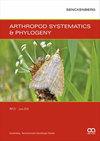Structural megadiversity in leaf litter predators - the head anatomy of Pselaphus heisei (Pselaphinae, Staphylinidae, Coleoptera)
IF 1.8
2区 农林科学
Q2 ENTOMOLOGY
引用次数: 5
Abstract
The head anatomy of Pselaphus heisei (Pselaphitae) is described and documented. The structural features are evaluated in comparison with findings presented in earlier studies on the subfamily, with a special focus on correlations with predacious habits and the groundplan of Pselaphinae. We found the tentorium, labrum, maxillary palps, shape of head, and a system of dorsal pits and sulci highly variable within the subfamily, reflecting multiple transformations, including many homoplasious changes. The following major characters are identified as groundplan features of Pselaphinae: falciform mandibles; small mola; semiglobular neck; ventrolateral antennal articulation; steep clypeal region; setiform labial palpomere 3; tentorium with nearly vertical main branches and lacking laminatentoria; separation of tentorial bridge from tentorial arms; fusion of dorsal tentorial arms with the head capsule; large brain placed in the posterior third of the head; and a triple cluster of well-developed cephalic glands. The last feature supports a hypothesis that multiple and independent cases of adaptations to myrmecophilous habits observed in various lineages of Pselaphinae were possible by re-programming already existing glands to produce appeasement secretions. The cephalic muscle apparatus of P. heisei is similar to what is found in other staphylinoid groups, with some exceptions, whereas it is strongly modified in the myrmecophile Claviger testaceus. We propose that the unparalleled structural megadiversity in Pselaphinae is primarily linked with life in the upper soil layers combined with specialized carnivorous habits, with small and agile or mechanically protected arthropods as prey. Within the group, various specialized life habits have evolved, including myrmecophily, termitophily, and also life in deep soil or caves, each with unique morphological adaptations.凋落叶捕食者的结构巨多样性——平头棘足蚜(棘足蚜科,棘足蚜科,鞘翅目)头部解剖
本文描述并记录了平头蛇的头部解剖结构。与早期对该亚科的研究结果进行比较,评估了结构特征,特别关注了与捕食习惯和地平面的相关性。我们发现,在亚科中,幕、唇、上颌触须、头部形状以及背窝和沟系统高度可变,反映了多种转化,包括许多同质变化。下列主要特征被确定为地平面特征:镰状下颌骨;小波;半球形的颈部;腹外侧触角关节;陡峭的直萼区;定形唇掌3;幕具几乎垂直的主分枝和缺乏层状幕;幕桥与幕臂分离;背幕臂与头囊融合;大脑袋:位于头部后三分之一的大脑袋;三组发育良好的头腺。最后一个特征支持了一个假设,即在不同的Pselaphinae谱系中观察到的多个独立的适应嗜蝇习性的案例可能是通过重新编程已经存在的腺体来产生安抚分泌物。P. heisei的头肌器官与其他葡萄球菌类类群相似,但有一些例外,而在嗜霉菌Claviger testaceus中有强烈的修饰。我们认为,Pselaphinae中无与伦比的结构多样性主要与上层土壤中的生活结合特殊的肉食性习性有关,它们以小而敏捷或机械保护的节肢动物为猎物。在这个群体中,各种特殊的生活习惯已经进化,包括嗜蚁、嗜白蚁,以及在深土或洞穴中的生活,每一种都有独特的形态适应。
本文章由计算机程序翻译,如有差异,请以英文原文为准。
求助全文
约1分钟内获得全文
求助全文
来源期刊

Arthropod Systematics & Phylogeny
Agricultural and Biological Sciences-Insect Science
CiteScore
2.50
自引率
5.60%
发文量
26
审稿时长
12 weeks
期刊介绍:
Arthropod Systematics & Phylogeny releases three times per year. Research fields covered are the taxonomy, morphology/anatomy, phylogeny (molecular or morphology-based), historical biogeography and palaeontology of arthropod taxa.
Arthropod Systematics & Phylogeny is the successor of Entomologische Abhandlungen, formerly published by the Museum of Zoology Dresden, Germany.
 求助内容:
求助内容: 应助结果提醒方式:
应助结果提醒方式:


